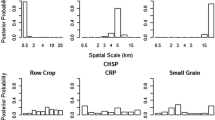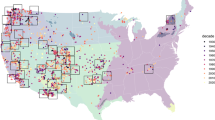Abstract
A regression slope of −0.75 between log10 density and log10 body mass is thought to express equivalence of energy conversion among species' populations of similar taxonomic and trophic status. Using larger sample sizes than the usual 1–3 density estimates per species, we estimated a regression slope of −0.71 for terrestrial mammalian carnivores. We investigated the sampling variation in this estimate, and those derived from smaller intra-specific subsets, using 1000-iteration bootstrap analyses to obtain 90% confidence intervals. As expected, these widened as random subsets were reduced in size, but always contained the postulated −0.75. However, log10 density also declined as 3/4 of the log10 spatial extent of study area, and study area accounted for virtually all of the variation in density that was previously thought due to body mass. We removed the effect of study area by using the species-specific regression models between density and study area to predict density at a common scale of 400 km2. These common-scale densities regressed against body mass with a slope of −0.16, but separated into body mass classes less than and greater than 11 kg, they produced slopes that were not significantly different from zero. We show that the allometry of density could be a case of circular logic, whereby body mass has influenced the investigator's choice of study area, and the resulting scale-dependent densities are related back to body mass. To test the allometry hypothesis, the effect of study area on density estimates needs to be removed. This requires conducting larger-scale studies of the smaller-bodied species so that all species compared are represented by an average study area that is near the common scale. Furthermore, study sites need to be selected and designed to represent more than the local detail in species' density.
Similar content being viewed by others
References
Blackburn TM, Gaston KJ (1996a) Abundance-body size relationships: the area you census tells you more. Oikos (in press)
Blackburn TM, Gaston KJ (1996b) Who is rare? Artefacts and complexities of rarity determination. In: Gaston KJ, Kunin WE (eds) The biology of rarity. Chapman and Hall, London
Blackburn TM, Harvey PH, Pagel MD (1990) Species number, population density and body-size relationships in natural communities. J Anim Ecol 59:335–345
Brown JH, Maurer BA (1986) Body size, ecological dominance and Cope's rule. Nature 324:248–282
Calder WA III (1983a) An allometric approach to cycles of population. J Theor Biol 100:275–282
Calder WA III (1983b) Ecological scaling: mammals and birds. Annu Rev Ecol Syst 14:213–230
Calder WA III (1984) Size, function, and life history, Harvard University Press, London
Clutton-Brock TH, Harvey PH (1983) The functional significance of variation in body size among mammals. In: Eisenberg JF, Kleiman DG (eds) Advances in the study of mammalian behavior, Special Publication 7. American Society of Mammalogists, Shippensburg, Pennsylvania, pp 632–663
Damuth J (1981) Population density and body size in mammals. Nature 290:699–700
Damuth J (1987) Interspecific allometry of population density in mammals and other animals: the independence of body mass and population energy-use. Biol J Linn Soc 31:193–246
Diaconis P, Efron B (1983) Computer-intensive methods in statistics. Sci Am 24:116–126, 128, 130, 170
Einstein A (1917) Cosmological considerations on the general theory of relativity. Sitzungsberichte der Preussischen Akad d Wissenschaften. English translation by Perret W, Jefferey GB (1923) The principle of relativity. Dover Publications, New York
Eisenberg JF (1980) The density and biomass of tropical mammals. In: Soule M, Wilcox B (eds) Conservation biology: an evolutionary-ecological perspective. Sinaur Associates, Sunderland, Mass, pp 35–55
Eisenberg JF, O'Connell MA, August PV (1979) Density, productivity, and distribution of mammals in two Venezuelan habitats. In: Eisenberg JF (ed) Vertebrate ecology in the northern neotropics. Smithsonian Institution Press, Washington, DC, pp 187–207
Felsenstein J (1985) Phylogenies and the comparative method. Am Nat 125:1–15
Garland T Jr (1983) Scaling the ecological cost of transport to body mass in terrestrial mammals. Am Nat 121:571–587
Gittleman JL (1986) Carnivore life history patterns: allometric, phylogenetic, and ecological associations. Am Nat 127:744–771
Harvey PH, Krebs JR (1990) Comparing brains. Science 249: 140–146
Hersenstein P, Macdonald DW (1982) Some comparisons between red and arctic foxes, Vulpes vulpes and Alopex lagopus, as revealed by radio tracking. Symp Zool Soc Lond 49:259–289
Holling CS (1992) Cross-scale morphology, geometry and dynamics of ecosystems. Ecol Monogr 62:447–502
Kleiber M (1932) Body size and metabolism. Hilgardia 6:315–353
Lawton JH (1989) What is the relationship between population density and body size in animals? Oikos 55:429–434
Levin S (1992) The problem of pattern and scale in ecology. Ecology 73:1943–1967
Mandelbrot BB (1977) Fractals: form, chance and dimension. Freeman, San Francisco
Margalef R (1968) Perspectives in ecological theory. University of Chicago Press, Chicago
McNab BK (1988) Complications inherent in scaling the basal rate of metabolism in mammals. Q Rev Biol 63:25–54
Mohr CO (1940) Comparative poulations of game, fur and other mammals. Am Midl Nat 24:581–584
Odum HT (1988) Self-organization, transformity, and information. Science 242:1132–1139
O'Neill RV, Deangelis DL, Waide JB, Allen TFH (1986) A hierarchical concept of ecosystems. Princeton University Press, Princeton, NJ
Peters RH (1983) The ecological implications of body size. Cambridge University Press, Cambridge
Peters RH (1991) A critique for ecology. Cambridge University Press, Cambridge
Peters RH, Raelson JV (1984) Relations between individual size and mammalian population density. Am Nat 124:498–517
Peters RH, Wassenberg K (1983) The effect of body size on animal abundance. Oecologia 60:89–96
Peterson RO, Page RE, Dodge KM (1984) Wolves, moose, and the allometry of population cycles. Science 224:1350–1352
Promislow DEL, Clobert J, Barbault R (1992) Life history allometry in mammals and squamate reptiles: taxon-level effects. Oikos 65:285–294
Robinson JG, Redford KH (1986) Body size, diet, and population density of neotropical forest mammals. Am Nat, 128:665–680
Schonewald-Cox C, Azari R, Blume S (1991) Scale, variable density, and conservation planning for mammalian Carnivores. Conserv Biol 5:491–495
Smallwood KS, Schonewald C (1996) Scaling population density and spatial pattern for terrestrial, mammalian carnivores. Oecologia 105:329–335
Taylor RAJ, Taylor LR (1979) A behavioral model for the evolution of spatial dynamics. In: Anderson RM, Turner BD, Taylor LR (eds) Population dymamics. Blackwell, Oxford, pp 1–28
Western D (1979) Size, life history and ecology in Mammals. Afr J Ecol 17:185–204
Western D (1983) Production, reproduction and size in mammals. Oecologia 59:269–271
Western D, Ssemakula J (1982) Life history patterns in birds and mammals and their evolutionary interpretation. Oecologia 54:281–290
Wiens JA (1989) Spatial scaling in ecology. Funct Ecol 3:385–397
Author information
Authors and Affiliations
Corresponding author
Rights and permissions
About this article
Cite this article
Smallwood, K.S., Jones, G. & Schonewald, C. Spatial scaling of allometry for terrestrial, mammalian carnivores. Oecologia 107, 588–594 (1996). https://doi.org/10.1007/BF00333952
Received:
Accepted:
Issue Date:
DOI: https://doi.org/10.1007/BF00333952




